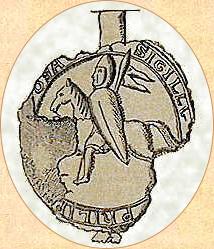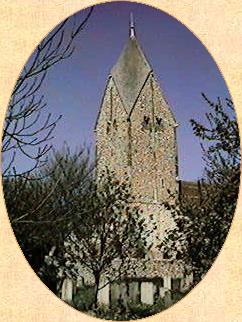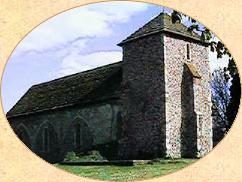
Crusading
Spirit

A
new order of fighting monks to defend the Holy Land, the Templars,
caught the imagination of many warlike benefactors, including
the Braoses. Saint Bernard of Clairvaux created holy orders for
the Knights Templar in 1128. One interpretation of the historical
record suggests that Philip
de Braose travelled
to Jerusalem more than once. (6.1)
Some of the earliest gifts
to the Templars came from his Sussex domains. Philip de Harcourt
bestowed the order with the manor and church of Shipley. (6.2) His brother, Richard de Rennesville, was a Templar.
Richard's tomb has survived at the old Templar Commanderie of
Saint Stephen, Rennesville.
Philip
de Braose's wife also gave five acres in Bramber to the Templars,
where Saint Mary's House now stands. (6.3)
This provided the order with free access to the port. The land
came from her dower and was given in honour of her crusading
husband. Philip de Harcourt added Saint Mary's Church in Sompting to their rapidly growing wealth in
1154. A small holding in the lost port of Pende, Lancing and
a chapel in Cokeham, Sompting came later.
 New
Shoreham was founded by Philip de Braose and became one of the
most prosperous English ports during the next three centuries.
Philip built the beautiful Saint Mary de Haura Church for his
town and gave it to Saint Florent Abbey of Saumur, possibly in
thanksgiving for a safe return from the Holy Land. The Templars
and the Knights Hospitaller established large houses at New Shoreham
but the river has long since washed away the remains. (6.4)
New
Shoreham was founded by Philip de Braose and became one of the
most prosperous English ports during the next three centuries.
Philip built the beautiful Saint Mary de Haura Church for his
town and gave it to Saint Florent Abbey of Saumur, possibly in
thanksgiving for a safe return from the Holy Land. The Templars
and the Knights Hospitaller established large houses at New Shoreham
but the river has long since washed away the remains. (6.4)
Returning crusaders frequently
introduced leprosy to the community. Philip or his son may have
been responsible for establishing the hospital of Saint Mary
Magdalen between Bramber and Steyning in the area still marked
with the name Maudlin. The bodies of medieval lepers were unearthed
here when a housing estate was built in 1959. They were examined
by archaeologists, then covered over in their burial place. (6.5)
Further evidence of lepers
can be found at Saint
Botolph's Church
nearby, on the Coombes Road. A low side window beside the altar
allowed lepers gathered outside to watch the service without
risk to the congregation.
 Philip's
death appears to be recorded by a 12th century writer, Gerald
of Wales. (6.6) Some time before 1136, Philip
and his dogs spent a night in the church of Saint Afan, or Llanafan
in Welsh. They had been hunting near Builth. At first light Philip
awoke to find that all his dogs had gone mad and he himself was
completely blind.
Philip's
death appears to be recorded by a 12th century writer, Gerald
of Wales. (6.6) Some time before 1136, Philip
and his dogs spent a night in the church of Saint Afan, or Llanafan
in Welsh. They had been hunting near Builth. At first light Philip
awoke to find that all his dogs had gone mad and he himself was
completely blind.
After years of "tedium
and darkness", Philip grasped an opportunity to redeem his
offence against the Church, "for he did not wish his spiritual
light to be extinguished as his eyes had been". He armed
himself and travelled to Jerusalem on a strong war horse, led
by a group of friends. They took him to the front line of battle,
where he gallantly charged forward. Philip was immediately struck
down by a sword blow and met an honourable death.

back to text

back to text

back to text
A new order of fighting monks to defend the Holy Land, the Templars, caught the imagination of many warlike benefactors, including the Braoses. Saint Bernard of Clairvaux created holy orders for the Knights Templar in 1128. One interpretation of the historical record suggests that Philip de Braose travelled to Jerusalem more than once. (6.1) Some of the earliest gifts to the Templars came from his Sussex domains. Philip de Harcourt bestowed the order with the manor and church of Shipley. (6.2) His brother, Richard de Rennesville, was a Templar. Richard's tomb has survived at the old Templar Commanderie of Saint Stephen, Rennesville. Philip de Braose's wife also gave five acres in Bramber to the Templars, where Saint Mary's House now stands. (6.3) This provided the order with free access to the port. The land came from her dower and was given in honour of her crusading husband. Philip de Harcourt added Saint Mary's Church in Sompting to their rapidly growing wealth in 1154. A small holding in the lost port of Pende, Lancing and a chapel in Cokeham, Sompting came later.
Returning crusaders frequently introduced leprosy to the community. Philip or his son may have been responsible for establishing the hospital of Saint Mary Magdalen between Bramber and Steyning in the area still marked with the name Maudlin. The bodies of medieval lepers were unearthed here when a housing estate was built in 1959. They were examined by archaeologists, then covered over in their burial place. (6.5) Further evidence of lepers can be found at Saint Botolph's Church nearby, on the Coombes Road. A low side window beside the altar allowed lepers gathered outside to watch the service without risk to the congregation.
After years of "tedium
and darkness", Philip grasped an opportunity to redeem his
offence against the Church, "for he did not wish his spiritual
light to be extinguished as his eyes had been". He armed
himself and travelled to Jerusalem on a strong war horse, led
by a group of friends. They took him to the front line of battle,
where he gallantly charged forward. Philip was immediately struck
down by a sword blow and met an honourable death.
|
||||||